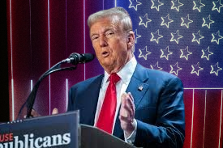
The Trump Flag: Unfurling Its Meaning, Evolution, and Enduring Presence in 2025
Introduction
Spot a bold flag fluttering on a pickup truck, draped over a porch railing, or even waving proudly at a local fairground. Chances are, if it features “TRUMP,” the iconic red and white stripes, or the unmistakable silhouette, you know exactly what – and who – it represents. The Trump flag isn’t just campaign merchandise; it’s become one of the most potent and recognizable political symbols in modern American history. But how did a simple flag evolve into this cultural lightning rod? What does flying one signify today, years after the peak of campaign rallies? And what’s the story behind its production and the passionate community that displays it? Buckle up, because we’re going beyond the surface, exploring the fascinating journey, complex meanings, and undeniable staying power of the Trump flag in 2025.
As an SEO specialist and blogger who’s tracked political trends and online behavior for over seven years, I’ve witnessed the Trump flag’s digital footprint explode and evolve. It’s not just about search volume (though that remains significant); it’s about understanding the deep currents of identity, loyalty, and political expression it taps into. Forget the simplistic narratives. This symbol is layered, controversial, and undeniably impactful. Whether you see it as a declaration of unwavering support, a nostalgic emblem, or a provocative statement, understanding its context is crucial for grasping a significant slice of the American socio-political landscape right now.
We’ll peel back the layers: tracing its origins from basic campaign swag to a multifaceted icon, decoding the visual language of its most popular designs, exploring the surprising economics of its production, and examining its role in contemporary political expression and community building. We’ll also tackle the practicalities and controversies head-on. By the end, you’ll have a much richer understanding of what that flag represents in 2025, far beyond the initial “Make America Great Again” slogan.
From Rally Giveaway to Cultural Icon: The Meteoric Rise of the Trump Flag
The story of the Trump flag begins, unsurprisingly, with the 2016 presidential campaign. While political banners are nothing new, the scale, fervor, and distinctiveness of the Trump campaign’s visual identity marked a shift. Early flags were often straightforward: the candidate’s name in large block letters, sometimes accompanied by the “Make America Great Again” (MAGA) slogan on a white background, perhaps with patriotic red and blue accents. They started appearing en masse at rallies – handed out, sold by vendors, and proudly hoisted by supporters amidst a sea of red hats.
What truly catalyzed the flag’s transformation from campaign prop to cultural symbol was the unprecedented level of grassroots enthusiasm. Supporters didn’t just attend rallies; they actively sought out ways to visibly proclaim their allegiance beyond the event. Flying a flag on one’s property or vehicle became a powerful, public statement. It signaled belonging to a movement perceived as challenging the political establishment. The flag became a unifying emblem for a diverse coalition drawn to Trump’s messaging on issues like immigration, trade, and national sovereignty. It wasn’t merely supporting a candidate; it was identifying with a cause and a community that felt overlooked or dismissed.
By the 2020 election cycle, the Trump flag had transcended its initial purpose. It was no longer just about the immediate campaign. It had morphed into a broader symbol of political identity, conservative values (as interpreted by his supporters), and often, a form of resistance against perceived cultural or political shifts. Its prevalence skyrocketed, becoming ubiquitous not just in traditional Republican strongholds but in suburban neighborhoods and rural areas nationwide. This explosion cemented its place in the visual lexicon of American politics, a status it largely retains heading deeper into 2025, even as the political landscape continues to evolve.
Decoding the Designs: What Different Trump Flags Symbolize
Not all Trump flags are created equal. Over the years, a rich visual vocabulary has emerged, with different designs carrying nuanced (and sometimes not-so-nuanced) meanings. Understanding these variations is key to interpreting the message behind the display.
-
The Classic “TRUMP” or “TRUMP 2020/2024” Banner: Often in stark white lettering on a vibrant red background, or sometimes red on white. This remains the most common and direct expression of support. It’s the bedrock design, signifying core allegiance to Donald Trump as a political figure. Seeing a faded “TRUMP 2020” flag in 2025 often signals enduring loyalty, a refusal to move on from that campaign’s energy or its perceived victories.
-
The “MAGA” Flag Variations: Incorporating the “Make America Great Again” slogan, sometimes fused with the Trump name, sometimes standing alone. These flags emphasize the ideological movement associated with Trump, focusing on the promise of national renewal, traditional values, and economic patriotism. Variations might include patriotic symbols like eagles or stars woven into the design. In 2025, these flags often represent a sustained commitment to the movement’s ideals, regardless of the daily political news cycle.
-
Patriotic Mashups & Thin Blue Line Flags: A significant trend involves integrating Trump branding with other potent American symbols. Flags merging the Trump name or “MAGA” with the Gadsden Flag (“Don’t Tread on Me”) signal a strong libertarian or anti-government sentiment alongside Trump support. The “Thin Blue Line” flag (black and white US flag with a blue stripe), when combined with Trump elements, signifies strong backing for law enforcement and the perception that Trump is their staunchest defender. These combinations amplify specific aspects of the supporter’s worldview.
-
“FJB” and Other Provocative Messaging: Some flags feature explicitly confrontational slogans like “FJB” (a derogatory acronym targeting President Biden) alongside Trump branding. Others might feature militaristic imagery or slogans like “Trump or Death.” These flags represent the most combative wing of the support base, prioritizing opposition to the current administration and a more aggressive political stance. Their display is often intentionally provocative.
The Engine Behind the Emblem: Manufacturing, Sales, and a Loyal Market
The sheer volume of Trump flags produced points to a significant, albeit niche, industry. While major retailers might carry basic designs during election seasons, the bulk of the market, especially for specialized or provocative designs, operates online and through small-scale vendors.
-
Manufacturing Hub: The vast majority of Trump flags, like most flags and banners sold in the US, are manufactured overseas, primarily in China. This is a simple reality of cost and scale. Production involves printing designs (often digitally) onto durable polyester or nylon fabric, then hemming and adding grommets. Quality varies widely, from flimsy, quickly-fading versions sold cheaply online to thicker, more weather-resistant flags commanding higher prices. Custom flag printing shops also cater to individuals wanting unique designs or smaller batches.
-
The Sales Ecosystem: Online marketplaces like Amazon, eBay, and Etsy are major distribution channels, offering immense variety. Dedicated conservative merchandise websites (e.g., the official Trump Store, conservative apparel sites) are crucial hubs, often selling higher-end or officially licensed items. Perhaps most iconic are the independent vendors – the folks selling flags, hats, and stickers from pop-up tents at rallies, fairs, flea markets, or roadside stands, especially in areas with high concentrations of supporters. This grassroots level is vital for community connection and impulse buys.
-
Market Resilience in 2025: Despite being out of office, the market for Trump flags hasn’t vanished. Sales undoubtedly peak during active campaign periods (like the 2024 cycle), but a steady baseline demand persists. This is driven by:
-
Enduring Loyalty: A core base continues to display flags as a sign of unwavering support and belief in Trump’s influence.
-
Nostalgia/Identity: For some, the flag represents the perceived successes or disruptive energy of the Trump presidency, a form of political nostalgia.
-
Oppositional Stance: Flying the flag remains a potent way to signal opposition to the current administration and its policies.
-
Community Marker: It signifies belonging to a like-minded community, both online and offline.
-
Table: Key Drivers of Trump Flag Demand Post-Presidency (2025)
| Driver | Description | Example in 2025 |
|---|---|---|
| Core Loyalty/Support | Unwavering belief in Donald Trump as a leader and continued advocacy for his agenda. | Flags flown year-round outside homes of dedicated supporters. |
| Movement Identification | Affiliation with the broader “MAGA” ideology and its associated values (as defined by supporters). | “MAGA” flags displayed alongside other conservative symbols. |
| Political Opposition | Using the flag as a visible symbol of dissent against the Biden administration and Democratic policies. | Increased flag visibility during major policy announcements or controversies. |
| Cultural Signaling | Marking territory or identity within a community, signaling shared beliefs and values. | Flags seen at local events, on vehicles in specific neighborhoods. |
| Nostalgia/Sentiment | Connection to the perceived energy, policies, or era of the Trump presidency. | Faded “TRUMP 2020” flags still displayed; merchandise referencing past slogans. |
Beyond the Pole: The Trump Flag in Contemporary Expression and Controversy
In 2025, the Trump flag functions in complex ways within the public sphere, often sparking intense reactions. Its display is rarely neutral.
-
Expression of Identity and Belief: For supporters, flying the flag is a deeply personal act. It’s a public declaration of political identity, core values (patriotism, conservative principles, anti-establishment sentiment), and belonging to a perceived community of like-minded individuals. It can be a source of pride and solidarity, especially in areas where such views are predominant. It signals, “This is who I am, and what I stand for.”
-
A Magnet for Controversy: The flag’s potency also makes it inherently controversial. To many critics, it has become inextricably linked not just to Donald Trump, but to the more divisive aspects of his presidency and rhetoric – including the January 6th Capitol attack, where numerous flags were present. For these observers, the flag can symbolize:
-
Support for actions or rhetoric perceived as divisive, xenophobic, or anti-democratic.
-
A rejection of political norms and institutions.
-
Alignment with far-right groups (though most flag flyers are not members of such groups, the symbol can be co-opted or perceived as adjacent).
-
-
Legal Battles and Community Tensions: The display often leads to friction:
-
HOA Disputes: Homeowners Associations frequently grapple with flags, citing covenants restricting signage or non-traditional flags (beyond the US/state/military flags). Legal battles often hinge on free speech rights versus contractual agreements. Recent rulings continue to be nuanced, often favoring HOA rules unless state laws specifically protect political signage.
-
Workplace Issues: Displaying prominent political symbols (like flags on vehicles parked at work or on desks) can create hostile work environment concerns. Most employers have policies limiting such displays to avoid conflict.
-
Public Perception & Social Divisions: The visible prevalence of Trump flags in a community can signal deep political divides, sometimes impacting neighborly relations or even local business patronage. It acts as a constant, visible reminder of the nation’s political polarization.
-
The Future of the Flag: Legacy, Evolution, or Fade?
What lies ahead for the Trump flag? Predicting political symbolism is tricky, but several trajectories seem plausible as we move through 2025 and beyond:
-
Enduring Symbol of a Movement: Regardless of Donald Trump’s personal political future, the “MAGA” movement he catalyzed shows no signs of disappearing. The flag is likely to remain a primary symbol for this significant segment of the conservative base. It represents a set of ideas and an identity that transcends any single election cycle. Expect to see it flown at conservative gatherings, on properties, and on vehicles for years to come as a marker of this political identity.
-
Nostalgia & Memorabilia: For some, the flag will transition into a piece of political memorabilia, representing a specific, impactful era in American politics. Much like buttons or posters from past campaigns, faded Trump flags might be kept as historical artifacts, evoking the intense passions of the late 2010s and early 2020s. Its meaning will shift from a current statement to a historical marker.
-
Evolution and Potential Co-option: The visual language might evolve. New slogans or design elements reflecting the movement’s future direction (post-Trump, whenever that may be) could emerge, perhaps incorporating the existing iconography but adapting it. There’s also the risk (or reality, depending on perspective) of the symbol being further co-opted by fringe groups, potentially altering its mainstream perception even more.
-
Gradual Fade (in some contexts): If the political energy of the MAGA movement significantly wanes or transforms without a clear successor to its current iconography, the specific Trump flag’s prominence could gradually diminish in everyday public display, becoming less common outside of dedicated rallies or core supporter strongholds. However, its historical significance as a potent political symbol is already cemented.
Considering Flying One? Practicalities and Points to Ponder
Thinking about displaying a Trump flag yourself? Here’s a quick reality check based on the current (2025) landscape:
-
Know Your Audience (and Rules): Be acutely aware of your surroundings. Are you in a deeply conservative area where it’s commonplace, or a more diverse or liberal community where it might be seen as deliberately provocative? Check local ordinances and, crucially, your HOA covenants (if applicable). Many HOAs strictly regulate flag size, type, and placement. Know the potential consequences before you hoist it.
-
Material Matters: Flags take a beating from sun, wind, and rain. Investing in a higher-quality, digitally printed polyester or nylon flag will last significantly longer and look better than the cheapest option. Look for reinforced stitching and brass grommets. A faded, tattered flag sends a very different message than a crisp, vibrant one.
-
Understand the Statement (and Backlash): Be honest with yourself about why you want to fly it and what message you intend to send. Recognize that it will be interpreted, sometimes negatively. Are you prepared for potential disagreements with neighbors, negative comments, or even impacts on business relationships (if displayed commercially)? Flying a highly polarizing symbol is rarely consequence-free. It’s a powerful statement – ensure it’s one you’re fully prepared to make.
Conclusion
The Trump flag is far more than dyed polyester. It’s a dense knot of political passion, cultural identity, historical significance, and social friction. Born on the 2016 campaign trail, it rapidly morphed from a simple promotional tool into arguably the most potent political symbol of its era – a visual shorthand for a complex movement and a presidency that reshaped American politics. In 2025, its persistence tells a story: a story of unwavering loyalty among a significant base, a story of ongoing political polarization, and a story of how symbols can take on lives of their own, carrying meanings both intended and ascribed.
Understanding the Trump flag requires looking beyond the surface. It means recognizing its varied designs and their nuanced messages, appreciating the surprisingly robust market that fuels its production, and grappling honestly with the intense reactions – both positive and negative – it provokes. It exists at the intersection of free expression, community identity, commercial enterprise, and deep political division. Whether it evolves into a lasting emblem of a movement, fades into nostalgic memorabilia, or takes on new forms, its impact on the visual and cultural landscape of early 21st-century America is undeniable. The next time you see one fluttering, remember: you’re not just looking at a flag. You’re looking at a piece of living, breathing, and often fiercely contested, political history.
FAQs: Your Trump Flag Questions, Answered (2025 Edition)
-
“Are Trump flags only about supporting Donald Trump now?” Not exactly. While direct support is still core for many, in 2025 it’s often just as much about identifying with the broader “MAGA” movement, conservative values as defined by his supporters, signaling opposition to the current administration, or simply expressing a particular political/cultural identity. It’s become a multifaceted symbol.
-
“My HOA says I can’t fly my Trump flag. Can they actually do that?” Unfortunately, probably yes, especially if your covenants specifically restrict signage or flags beyond the US/state/military flags. HOAs are private contractual agreements, and courts often uphold their rules on aesthetic uniformity. Free speech arguments against HOAs usually have limited success unless your state has passed specific laws protecting political signage (check your local laws!). It’s a common source of dispute.
-
“What’s the deal with all the different designs? Is there a ‘main’ one?” There’s no single “official” design beyond what the campaign itself sold. The classic “TRUMP” banner is the most common. “MAGA” flags emphasize the movement. Designs incorporating the Gadsden snake (“Don’t Tread on Me”) or Thin Blue Line signal specific ideological blends (libertarian/anti-government or strong pro-police stances). More provocative slogans represent a more confrontational wing. Choice of design sends a specific message.
-
“I see way fewer flags now than in 2020. Is the trend dying?” It’s definitely less ubiquitous than during the peak campaign fever, which is natural. However, reporting and observations suggest a strong baseline level persists in 2025, particularly in core support areas and among dedicated individuals. It’s transitioned from a purely campaign symbol to a more enduring marker of political identity for a significant group. Don’t mistake decreased frenzy for disappearance.
-
“Where are these things even made? Is it a big business?” The vast majority are manufactured overseas (primarily China) for cost reasons, just like most flags sold in the US. It’s a niche but resilient market. Sales happen online (Amazon, eBay, conservative sites), through official campaign stores (when active), and crucially, via independent vendors at rallies, fairs, and roadside spots. Demand fluctuates but hasn’t vanished post-presidency – loyalty, opposition, and identity keep it going.




